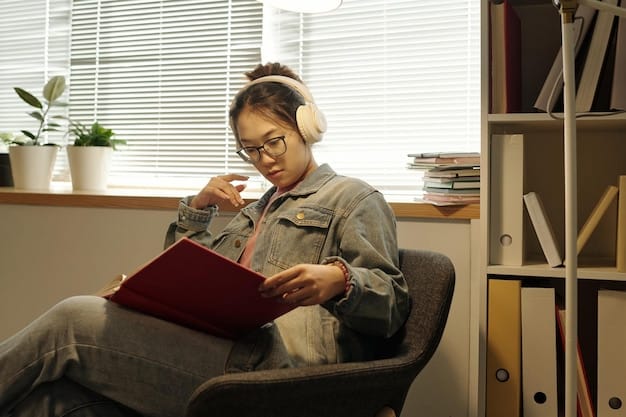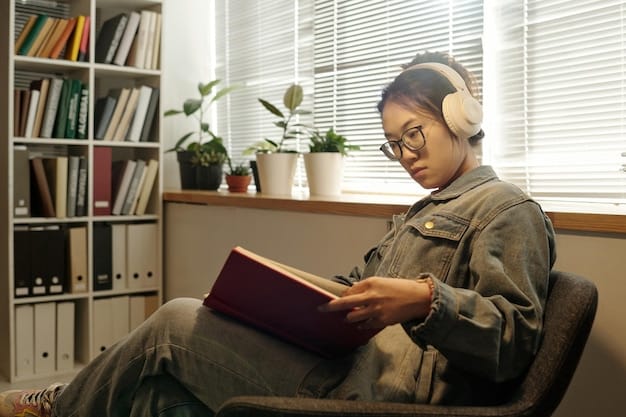Adapt Your Study Habits: Unlock Learning Potential & Save Time

Adapt your study habits by understanding your learning style, which can significantly improve efficiency and comprehension, potentially saving you up to 10 hours a week by focusing on methods that align with how you learn best.
Do you ever feel like you’re spending hours studying but not really retaining the information? The key may not be studying *more*, but studying *smarter*. Understanding and adapting to your individual learning style can transform your study sessions, making them more effective and even saving you valuable time. Discover how to adapt your study habits can unlock your learning potential and save you 10 hours a week.
Why Understanding Your Learning Style Matters
Most people approach studying with a one-size-fits-all mentality, using the same techniques regardless of the subject matter or their own preferences. However, recognizing your unique learning style is the first step towards a more efficient and enjoyable academic journey. But, what exactly does this entail, and why is it so important?
Your learning style refers to the way you best absorb, process, comprehend, and retain information. It’s about understanding which techniques and environments are most conducive to your learning. Ignoring your learning style can lead to frustration, wasted time, and a feeling of inadequacy, even when you’re putting in a lot of effort.
The Frustration of Mismatched Methods
Imagine trying to fit a square peg into a round hole – that’s what studying can feel like when you’re using methods that don’t align with your learning style. Visual learners might struggle with auditory lectures, while kinesthetic learners may find themselves fidgeting and unable to concentrate during long reading assignments.
Boosting Efficiency and Enjoyment
On the other hand, when you embrace your learning style, studying becomes more efficient and enjoyable. You’re able to absorb information more quickly, retain it for longer, and even find the learning process more engaging. This can lead to better grades, increased confidence, and a more positive attitude towards education.
- Personalized Study Strategies: Discover strategies tailored to how your brain works.
- Increased Motivation: Enjoy learning more when it aligns with your natural preferences.
- Improved Retention: Remember more by using methods that resonate with you.
- Reduced Study Time: Study smarter, not harder, saving valuable time each week.
In essence, understanding your learning style is about self-awareness and empowerment. It’s about taking control of your education and creating a learning experience that works for *you*. By adapting your study habits to match your learning style, you’re not just improving your grades – you’re also cultivating a lifelong love of learning.
Identifying the Primary Learning Styles
While everyone learns differently, most people tend to lean towards one or two primary learning styles. These styles categorize how individuals best process and retain new information. Understanding these basic categories can help you identify your own strengths and preferences. Let’s explore the four most commonly recognized learning styles.
Each learning style has its own strengths and weaknesses, and most people benefit from incorporating elements of multiple styles into their study habits. However, identifying your dominant learning style is a great starting point for creating a more personalized and effective learning strategy.

Visual Learners
Visual learners understand information best when it is presented in a visual format. They thrive on images, diagrams, charts, and videos. Color-coding, mind mapping, and using flashcards can be particularly effective for visual learners.
Auditory Learners
Auditory learners prefer to learn through listening and speaking. They benefit from lectures, discussions, and audio recordings. Reading aloud, explaining concepts to others, and using mnemonic devices can be helpful for auditory learners.
Reading/Writing Learners
Reading/writing learners excel when information is presented in written form. They enjoy note-taking, reading textbooks, and writing essays. Summarizing information, creating outlines, and rewriting notes are effective strategies for reading/writing learners.
Kinesthetic Learners
Kinesthetic learners learn best through hands-on experiences and physical activity. They benefit from experiments, projects, and role-playing. Taking breaks to move around, using physical objects to visualize concepts, and teaching others can be beneficial for kinesthetic learners.
By understanding these four learning styles, you can begin to identify your own preferences and tailor your study habits accordingly. Experiment with different techniques and observe which ones resonate most with you. The goal is to create a learning experience that is both effective and enjoyable.
Strategies for Visual Learners to Maximize Learning
If you’re a visual learner, sight is your strongest sense when it comes to retaining information. Transforming abstract concepts into visual representations can significantly enhance your comprehension and memory. Let’s explore strategies tailored specifically for visual learners, designed to help you maximize your learning potential.
These strategies are designed to engage your visual senses and help you create a mental picture of the information you’re learning. By incorporating these techniques into your study routine, you can make learning more effective, efficient, and even enjoyable.
Utilize Mind Maps and Diagrams
Mind maps are a powerful tool for visual learners. Start with a central idea and branch out with related concepts, using colors, images, and keywords to create a visual representation of the information. Diagrams can also be helpful for illustrating relationships between different concepts.
Watch Educational Videos and Documentaries
Take advantage of the wealth of educational videos and documentaries available online. Platforms like YouTube, Khan Academy, and Coursera offer visual explanations of a wide range of subjects. Watching these videos can help you visualize concepts and make learning more engaging.
- Color-Code Your Notes: Use different colors to highlight key information.
- Create Flashcards with Images: Include visual aids instead of just text.
- Visualize Concepts: Imagine the concepts you’re learning in your mind.
- Use Graphic Organizers: Structure information visually with charts and tables.
For example, when learning about historical events, create a timeline with images and key dates. When studying scientific concepts, draw diagrams to illustrate processes and relationships. The more you can transform abstract information into visual representations, the better you’ll be able to understand and remember it.
Effective Study Techniques for Auditory Learners
Auditory learners thrive when they can hear and speak information. If you identify as an auditory learner, prioritizing listening and verbalization techniques can significantly improve your study sessions. Let’s explore some effective study techniques tailored for auditory learners.
These techniques are designed to engage your auditory senses and help you process information through sound and speech. By incorporating these strategies into your study routine, you can make learning more interactive, engaging, and effective.

Participate in Discussions and Debates
Auditory learners often benefit from discussing concepts with others. Join study groups, participate in class discussions, and even debate topics with friends. This allows you to hear different perspectives and verbalize your own understanding, reinforcing the information in your mind.
Record Lectures and Listen to Them Later
If allowed, record lectures and listen to them later while taking notes or doing other tasks. Hearing the information again can help you solidify your understanding and identify areas where you need to focus more attention.
- Read Aloud: Reading your notes or textbook aloud can improve comprehension.
- Explain Concepts to Others: Teaching others reinforces your own understanding.
- Use Mnemonic Devices: Create rhymes or songs to remember key information.
- Listen to Audiobooks: Learn while commuting or doing chores.
When studying for an exam, try explaining the concepts to a friend or family member. This not only helps you identify any gaps in your knowledge but also reinforces the information through verbalization. The more you can integrate listening and speaking into your study routine, the more effective your learning will be.
Optimizing Study Sessions for Reading/Writing Learners
Reading/writing learners excel when information is presented in written form. They have a natural affinity for reading and writing, and they learn best when they can engage with text-based materials. Let’s explore some strategies to optimize your study sessions if you identify as a reading/writing learner.
These techniques are designed to engage your reading and writing skills, allowing you to process and retain information through text-based activities. By incorporating these strategies into your study routine, you can leverage your strengths and make learning more effective and enjoyable.
Take Detailed Notes and Summarize Information
Reading/writing learners often benefit from taking detailed notes during lectures or while reading. Then, summarize the information in your own words, creating concise and organized summaries that you can review later.
Rewrite Notes and Create Outlines
Rewriting your notes can be a powerful way to reinforce information. As you rewrite, you’re actively engaging with the material and solidifying your understanding. Creating outlines can also help you organize your thoughts and identify key concepts.
- Use Textbooks and Articles: Prioritize reading assignments.
- Write Essays and Reports: Practice your writing skills to express your understanding.
- Create Study Guides: Organize information in a written format.
- Write Practice Questions: Test your knowledge with written questions.
When studying for an exam, try creating a comprehensive study guide that summarizes all the key concepts and information. This will not only help you organize your thoughts but also provide you with a valuable resource to review later. The more you can integrate reading and writing into your study routine, the more effective your learning will be.
Harnessing Kinesthetic Learning for Better Retention
Kinesthetic learners learn best through hands-on experiences and physical activity. If you identify as a kinesthetic learner, incorporating movement and tactile activities into your study sessions can significantly improve your retention and understanding. Let’s explore some strategies to harness kinesthetic learning for better retention.
These techniques are designed to engage your sense of touch and movement, allowing you to process information through physical activities. By incorporating these strategies into your study routine, you can make learning more interactive, engaging, and effective.
Incorporate Movement and Breaks
Kinesthetic learners often struggle to sit still for long periods of time. Incorporate movement into your study sessions by taking frequent breaks to walk around, stretch, or do some light exercise. This can help you stay focused and energized.
Use Hands-on Activities and Experiments
Engage in hands-on activities and experiments whenever possible. Build models, conduct experiments, or create physical representations of the concepts you’re learning. This allows you to experience the information in a tangible way.
- Role-Play and Act Out Concepts: Bring learning to life with physical enactment.
- Use Manipulatives: Use physical objects to visualize concepts.
- Take Field Trips: Experience learning in a real-world setting.
- Teach Others: Get hands-on by guiding someone else through the material.
For example, when learning about the human body, build a model of a cell or conduct a dissection. When studying history, visit a museum or historical site. When learning a new language, practice speaking with native speakers. The more you can integrate movement and tactile activities into your study routine, the more effective your learning will be.
| Key Concept | Brief Description |
|---|---|
| 🧠 Learning Styles | Understand how you best absorb and retain information. |
| 👁️ Visual Learning | Use images, diagrams, and videos for effective learning. |
| 🎧 Auditory Learning | Benefit from lectures, discussions, and audio recordings. |
| ✍️ Reading/Writing | Excel with written materials, notes, and summaries. |
Frequently Asked Questions
▼
Start by reflecting on how you best learn in different situations. Consider which methods you enjoy and find most effective. Online quizzes and assessments can also provide insights, but self-reflection is key.
▼
Yes, many people have a combination of learning styles. You might find that you’re primarily visual but also benefit from auditory or kinesthetic techniques. Experiment and find what works best for you.
▼
No, each learning style has its strengths and weaknesses. The goal is not to be a certain type of learner, but to understand your preferences and adapt your study habits accordingly. The “best” style is the one that works for you.
▼
Regularly assess your learning strategies. As you progress in your studies, you might find that your preferences evolve. Be open to experimenting with new techniques and adjusting your study habits as needed for optimal results.
▼
Yes, by focusing on techniques that align with your learning style, you can absorb information more quickly and retain it for longer. This can significantly reduce the amount of time you spend studying while improving your grades considerably.
Conclusion
Adapting your study habits to match your learning style is a powerful strategy for unlocking your full academic potential. By understanding how you best absorb and retain information, you can create a more personalized, efficient, and enjoyable learning experience, ultimately saving you time and improving your grades.





